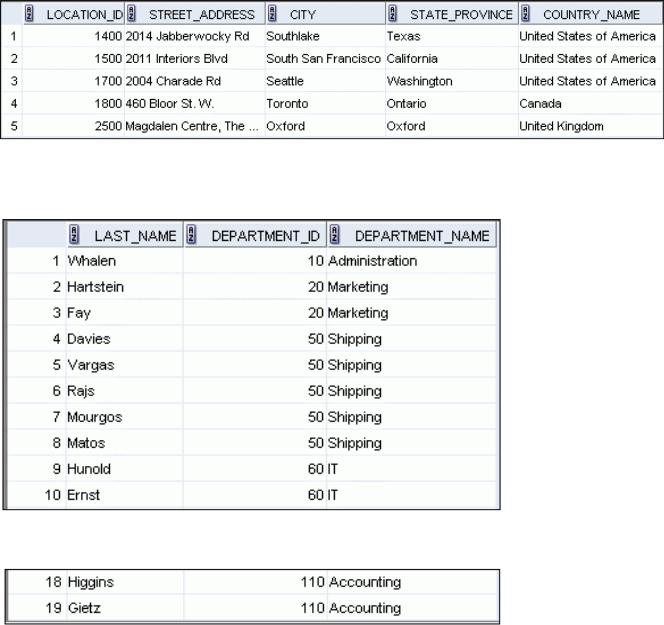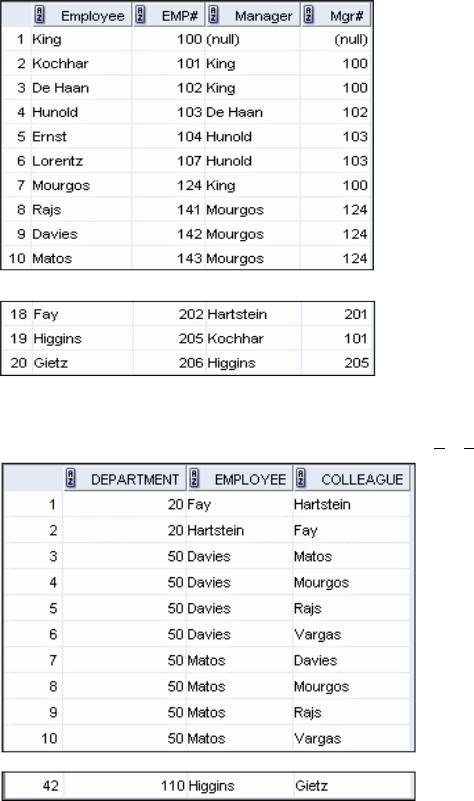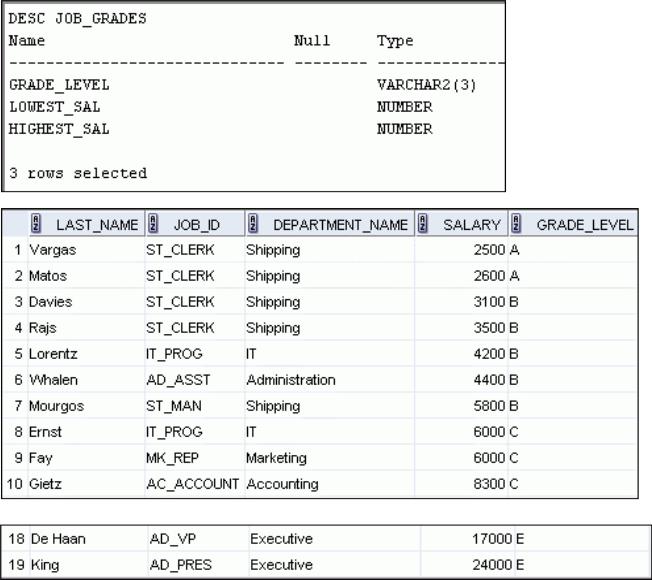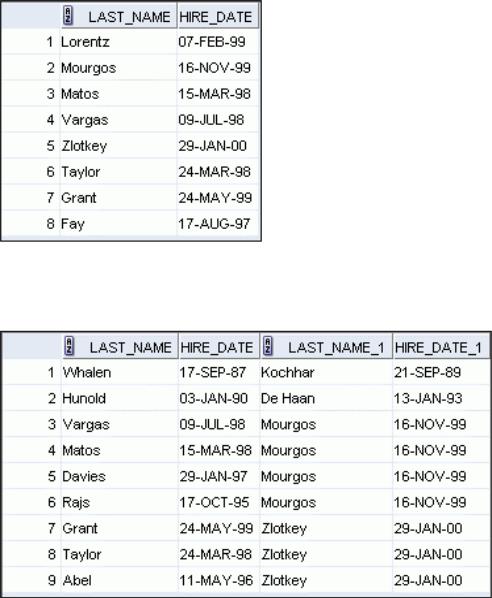
- •Preface
- •Introduction
- •Lesson Objectives
- •Lesson Agenda
- •Course Objectives
- •Course Agenda
- •Appendixes Used in the Course
- •Lesson Agenda
- •Oracle Database 11g: Focus Areas
- •Oracle Database 11g
- •Oracle Fusion Middleware
- •Oracle Enterprise Manager Grid Control 10g
- •Oracle BI Publisher
- •Lesson Agenda
- •Relational and Object Relational Database Management Systems
- •Data Storage on Different Media
- •Relational Database Concept
- •Definition of a Relational Database
- •Data Models
- •Entity Relationship Model
- •Relating Multiple Tables
- •Relational Database Terminology
- •Lesson Agenda
- •Using SQL to Query Your Database
- •SQL Statements
- •Development Environments for SQL
- •Lesson Agenda
- •The Human Resources (HR) Schema
- •Tables Used in the Course
- •Lesson Agenda
- •Oracle Database 11g Documentation
- •Additional Resources
- •Summary
- •Practice I: Overview
- •Objectives
- •Lesson Agenda
- •Capabilities of SQL SELECT Statements
- •Basic SELECT Statement
- •Selecting All Columns
- •Selecting Specific Columns
- •Writing SQL Statements
- •Column Heading Defaults
- •Lesson Agenda
- •Arithmetic Expressions
- •Using Arithmetic Operators
- •Operator Precedence
- •Defining a Null Value
- •Null Values in Arithmetic Expressions
- •Lesson Agenda
- •Defining a Column Alias
- •Using Column Aliases
- •Lesson Agenda
- •Concatenation Operator
- •Literal Character Strings
- •Using Literal Character Strings
- •Alternative Quote (q) Operator
- •Duplicate Rows
- •Lesson Agenda
- •Displaying the Table Structure
- •Using the DESCRIBE Command
- •Quiz
- •Summary
- •Practice 1: Overview
- •Objectives
- •Lesson Agenda
- •Limiting Rows Using a Selection
- •Limiting the Rows That Are Selected
- •Using the WHERE Clause
- •Character Strings and Dates
- •Comparison Operators
- •Using Comparison Operators
- •Range Conditions Using the BETWEEN Operator
- •Membership Condition Using the IN Operator
- •Pattern Matching Using the LIKE Operator
- •Combining Wildcard Characters
- •Using the NULL Conditions
- •Defining Conditions Using the Logical Operators
- •Using the AND Operator
- •Using the OR Operator
- •Using the NOT Operator
- •Lesson Agenda
- •Rules of Precedence
- •Lesson Agenda
- •Using the ORDER BY Clause
- •Sorting
- •Lesson Agenda
- •Substitution Variables
- •Using the Single-Ampersand Substitution Variable
- •Character and Date Values with Substitution Variables
- •Specifying Column Names, Expressions, and Text
- •Using the Double-Ampersand Substitution Variable
- •Lesson Agenda
- •Using the DEFINE Command
- •Using the VERIFY Command
- •Quiz
- •Summary
- •Practice 2: Overview
- •Objectives
- •Lesson Agenda
- •SQL Functions
- •Two Types of SQL Functions
- •Single-Row Functions
- •Lesson Agenda
- •Character Functions
- •Case-Conversion Functions
- •Using Case-Conversion Functions
- •Character-Manipulation Functions
- •Using the Character-Manipulation Functions
- •Lesson Agenda
- •Number Functions
- •Using the ROUND Function
- •Using the TRUNC Function
- •Using the MOD Function
- •Lesson Agenda
- •Working with Dates
- •RR Date Format
- •Using the SYSDATE Function
- •Arithmetic with Dates
- •Using Arithmetic Operators with Dates
- •Lesson Agenda
- •Date-Manipulation Functions
- •Using Date Functions
- •Using ROUND and TRUNC Functions with Dates
- •Quiz
- •Summary
- •Practice 3: Overview
- •Objectives
- •Lesson Agenda
- •Conversion Functions
- •Implicit Data Type Conversion
- •Explicit Data Type Conversion
- •Lesson Agenda
- •Using the TO_CHAR Function with Dates
- •Elements of the Date Format Model
- •Using the TO_CHAR Function with Dates
- •Using the TO_CHAR Function with Numbers
- •Using the TO_NUMBER and TO_DATE Functions
- •Using the TO_CHAR and TO_DATE Function with RR Date Format
- •Lesson Agenda
- •Nesting Functions
- •Lesson Agenda
- •General Functions
- •NVL Function
- •Using the NVL Function
- •Using the NVL2 Function
- •Using the NULLIF Function
- •Using the COALESCE Function
- •Lesson Agenda
- •Conditional Expressions
- •CASE Expression
- •Using the CASE Expression
- •DECODE Function
- •Using the DECODE Function
- •Quiz
- •Summary
- •Practice 4: Overview
- •Objectives
- •Lesson Agenda
- •What Are Group Functions?
- •Types of Group Functions
- •Group Functions: Syntax
- •Using the AVG and SUM Functions
- •Using the MIN and MAX Functions
- •Using the COUNT Function
- •Using the DISTINCT Keyword
- •Group Functions and Null Values
- •Lesson Agenda
- •Creating Groups of Data
- •Creating Groups of Data: GROUP BY Clause Syntax
- •Using the GROUP BY Clause
- •Grouping by More than One Column
- •Using the GROUP BY Clause on Multiple Columns
- •Illegal Queries Using Group Functions
- •Restricting Group Results
- •Restricting Group Results with the HAVING Clause
- •Using the HAVING Clause
- •Lesson Agenda
- •Nesting Group Functions
- •Quiz
- •Summary
- •Practice 5: Overview
- •Objectives
- •Lesson Agenda
- •Types of Joins
- •Joining Tables Using SQL:1999 Syntax
- •Qualifying Ambiguous Column Names
- •Lesson Agenda
- •Creating Natural Joins
- •Retrieving Records with Natural Joins
- •Creating Joins with the USING Clause
- •Joining Column Names
- •Retrieving Records with the USING Clause
- •Using Table Aliases with the USING Clause
- •Creating Joins with the ON Clause
- •Retrieving Records with the ON Clause
- •Creating Three-Way Joins with the ON Clause
- •Applying Additional Conditions to a Join
- •Lesson Agenda
- •Joining a Table to Itself
- •Self-Joins Using the ON Clause
- •Lesson Agenda
- •Nonequijoins
- •Retrieving Records with Nonequijoins
- •Lesson Agenda
- •INNER Versus OUTER Joins
- •LEFT OUTER JOIN
- •RIGHT OUTER JOIN
- •FULL OUTER JOIN
- •Lesson Agenda
- •Cartesian Products
- •Generating a Cartesian Product
- •Creating Cross Joins
- •Quiz
- •Summary
- •Practice 6: Overview
- •Objectives
- •Lesson Agenda
- •Using a Subquery to Solve a Problem
- •Subquery Syntax
- •Using a Subquery
- •Guidelines for Using Subqueries
- •Types of Subqueries
- •Lesson Agenda
- •Single-Row Subqueries
- •Executing Single-Row Subqueries
- •Using Group Functions in a Subquery
- •The HAVING Clause with Subqueries
- •What Is Wrong with This Statement?
- •No Rows Returned by the Inner Query
- •Lesson Agenda
- •Multiple-Row Subqueries
- •Lesson Agenda
- •Null Values in a Subquery
- •Quiz
- •Summary
- •Practice 7: Overview
- •Objectives
- •Lesson Agenda
- •Set Operators
- •Set Operator Guidelines
- •The Oracle Server and Set Operators
- •Lesson Agenda
- •Tables Used in This Lesson
- •Lesson Agenda
- •UNION Operator
- •Using the UNION Operator
- •UNION ALL Operator
- •Using the UNION ALL Operator
- •Lesson Agenda
- •INTERSECT Operator
- •Using the INTERSECT Operator
- •Lesson Agenda
- •MINUS Operator
- •Using the MINUS Operator
- •Lesson Agenda
- •Matching the SELECT Statements
- •Matching the SELECT Statement: Example
- •Lesson Agenda
- •Using the ORDER BY Clause in Set Operations
- •Quiz
- •Summary
- •Practice 8: Overview

Quiz
The SQL:1999 standard join syntax supports the following types of joins. Which of these join types does Oracle join syntax support?
1.Equijoins
2.Nonequijoins
3.Left OUTER join
4.Right OUTER join
5.Full OUTER join
6.Self joins
7.Natural joins
8.Cartesian products
Answer: 1, 2, 3, 4, 6, 8 |
Copyright © 2009, Oracle. All rights reserved. |
Academy |
|||
|
|
|
|||
|
|
|
Oracle |
||
|
|
& |
Only |
|
|
|
Internal |
|
|
|
|
Oracle |
Use |
|
|||
|
|
|
|
||
Oracle Database 11g: SQL Fundamentals I 6 - 35

Summary
In this lesson, you should have learned how to use joins to display data from multiple tables by using:
•Equijoins
•Nonequijoins
•OUTER joins
•Self-joins
•Cross joins
•Natural joins
•Full (or two-sided) OUTER joins
Summary |
|
|
Academy |
|||
|
|
Copyright © 2009, Oracle. All rights reserved. |
|
|
||
|
There are multiple ways to join tables. |
Oracle |
||||
|
|
|
|
|
||
|
Types of Joins |
|
|
|
|
|
|
• |
Equijoins |
|
|
|
|
|
• |
Nonequijoins |
|
Only |
|
|
|
• |
OUTER joins |
& |
|
|
|
|
|
|
|
|||
|
• |
Self-joins |
|
|
|
|
|
A Cartesian productInternalresults in the display of all combinations of rows. This is done by either omitting |
|||||
|
• |
Cross joins |
Use |
|
|
|
|
• |
Natural joins |
|
|
||
|
• Full (or two-sided) OUTER joins |
|
|
|||
|
Cartesian Products |
|
|
|||
Oracle |
|
|
|
|
||
|
the WHERE c ause or by specifying the CROSS JOIN clause. |
|
|
|||
|
Table Aliases |
|
|
|
|
|
|
• |
T ble aliases speed up database access. |
|
|
|
|
• Table aliases can help to keep SQL code smaller by conserving memory.
• Table aliases are sometimes mandatory to avoid column ambiguity.
Oracle Database 11g: SQL Fundamentals I 6 - 36

Practice 6: Overview
This practice covers the following topics:
•Joining tables using an equijoin
•Performing outer and self-joins
•Adding conditions
Practice 6: Overview |
Copyright © 2009, Oracle. All rights reserved. |
Academy |
||||
|
|
|
|
|||
|
|
|
Oracle |
|||
|
This practice is intended to give you experience in extracting data from more than one table using the |
|||||
|
SQL:1999–compliant joins. |
|
|
Only |
|
|
|
|
& |
|
|
||
|
Internal |
|
|
|
|
|
Oracle |
Use |
|
|
|||
|
|
|
|
|
||
Oracle Database 11g: SQL Fundamentals I 6 - 37

Practice 6
1.Write a query for the HR department to produce the addresses of all the departments. Use the LOCATIONS and COUNTRIES tables. Show the location ID, street address, city, state or province, and country in the output. Use a NATURAL JOIN to produce the results.
2.The HR department needs a report of all employees. Write a query to display the last name, department number, and department name for all the employees.
|
|
Academy |
… |
Oracle |
|
|
& |
Only |
Internal |
|
|
Oracle |
Use |
|
|
|
|
Oracle Database 11g: SQL Fundamentals I 6 - 38

Practice 6 (continued)
3.The HR department needs a report of employees in Toronto. Display the last name, job, department number, and the department name for all employees who work in Toronto.
4.Create a report to display employees’ last name and employee number along with their manager’s last name and manager number. Label the columns Employee, Emp#, Manager, and Mgr#, respectively. Save your SQL statement as lab_06_04.sql. Run the query.
… |
|
Academy |
|
Oracle |
|||
|
|||
|
& |
Only |
|
Internal |
|
||
Oracle |
Use |
||
|
|
||
Oracle Database 11g: SQL Fundamentals I 6 - 39

Practice 6 (continued)
5.Modify lab_06_04.sql to display all employees including King, who has no manager. Order the results by the employee number. Save your SQL statement as lab_06_05.sql. Run the query in lab_06_05.sql.
6. Create a report for the HR department that displays employee lastAcademynames, department numbers,
and all the employees who work in the same department as a given employee. Give each column an appropriate label. Save the script to a file named lab 06 06.sql.
Oracle |
|
& |
Only |
Internal |
|
Use |
|
Oracle |
|
… |
|
Oracle Database 11g: SQL Fundamentals I 6 - 40

Practice 6 (continued)
7.The HR department needs a report on job grades and salaries. To familiarize yourself with the JOB_GRADES table, first show the structure of the JOB_GRADES table. Then create a query
that displays the name, job, department name, salary, and grade for all employees.
|
|
Academy |
… |
Oracle |
|
|
& |
Only |
Internal |
|
|
Oracle |
Use |
|
|
|
|
Oracle Database 11g: SQL Fundamentals I 6 - 41

Practice 6 (continued)
If you want an extra challenge, complete the following exercises:
8.The HR department wants to determine the names of all the employees who were hired after Davies. Create a query to display the name and hire date of any employee hired after employee Davies.
9. The HR department needs to find the names and hire dates of all the employees who were hired before their managers, along with their managers’ names and hire dates. Save the script to a file
named lab_06_09.sql. |
|
Academy |
|
|
|
|
Oracle |
|
|
& |
Only |
Internal |
|
|
Oracle |
Use |
|
|
|
|
Oracle Database 11g: SQL Fundamentals I 6 - 42

Using Subqueries to Solve Queries
|
Copyright © 2009, Oracle. All rights reserved. |
Academy |
||
|
|
|||
|
|
Oracle |
||
& |
Only |
|
||
|
Internal |
|
|
|
|
Use |
|
||
Oracle |
|
|
|
|
